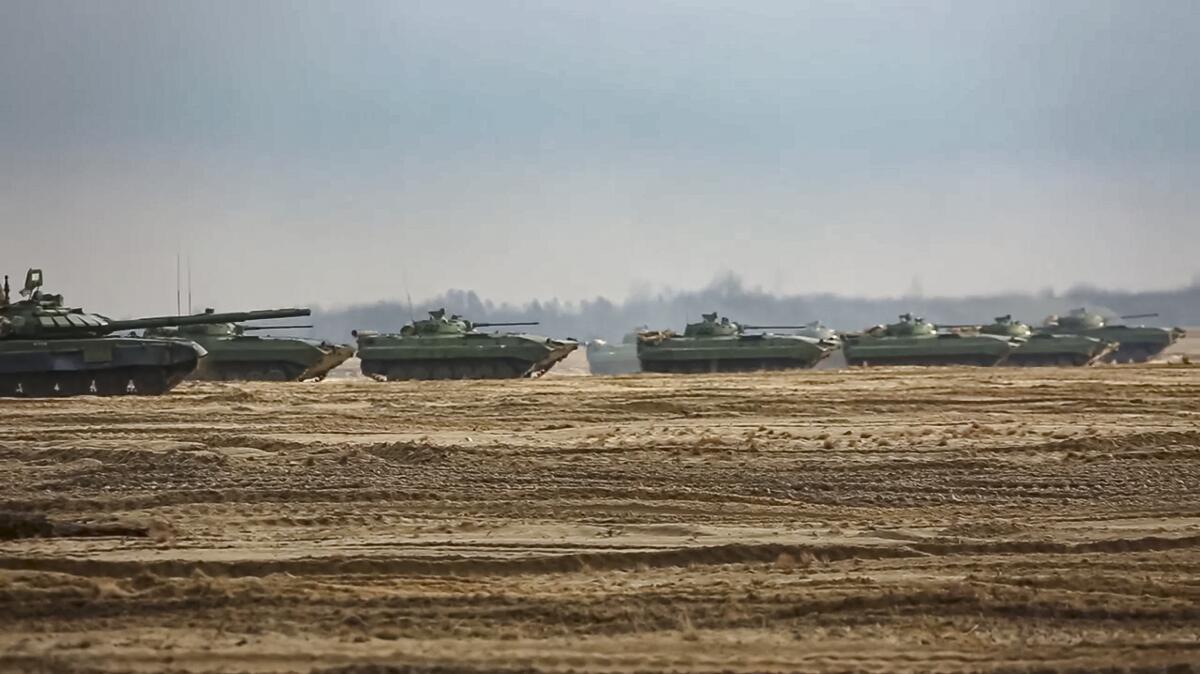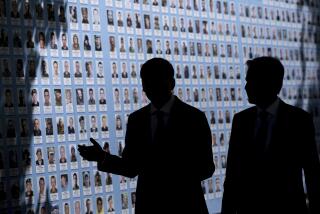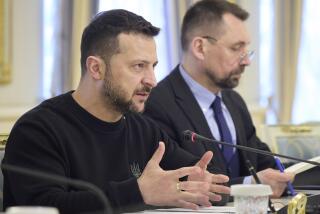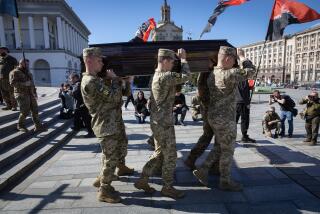U.S. reports more than 130,000 Russian troops now staged outside Ukraine

- Share via
WASHINGTON — Some airlines canceled flights to the Ukrainian capital and troops unloaded fresh shipments of weapons from NATO members Sunday, as the nation’s president sought to project confidence in the face of U.S. warnings of possible invasion within days by a growing number of Russian forces.
President Volodymyr Zelensky spoke to President Biden for about an hour, insisting that Ukrainians had the country under “safe and reliable protection” against a feared attack by a far stronger Russian military, aides said. The White House said both agreed to keep pushing deterrence and diplomacy to try to stave off a Russian military offensive.
The Biden administration has become increasingly outspoken about its concerns that Russia will stage an incident in the coming days that would create a false pretext for an invasion.
U.S. and European intelligence findings in recent days have sparked worries that Russia may try to target a scheduled Ukrainian military exercise slated for Tuesday in eastern Ukraine to launch such a “false-flag operation,” according to two people familiar with the matter. They spoke on condition of anonymity because they were not authorized to speak publicly about it.
American intelligence officials believe targeting the military exercise is just one of multiple options Russia has weighed as a possibility for a false-flag operation. The White House has underscored that it does not know with certainty if President Vladimir Putin has made a final determination to invade.
Moscow’s forces are massing on Ukraine’s north, east and south in what the Kremlin insists are military exercises.
The U.S. updated its estimate for how many Russian forces were now staged near Ukraine’s borders to more than 130,000, up from the 100,000 the U.S. has cited publicly in previous weeks. A U.S. official gave the estimate, speaking on condition of anonymity to discuss the administration’s conclusion.
Zelensky has repeatedly played down the U.S. warnings, questioning the increasingly strident statements from U.S. officials in recent days that Russia could be planning to invade as soon as midweek.
“We understand all the risks; we understand that there are risks,” he said in a live broadcast. “If you, or anyone else, has additional information regarding a 100% Russian invasion starting on the 16th, please forward that information to us.”
Though Zelensky has urged against panic that he fears could undermine Ukraine’s economy, he and his civilian and military leaders also are preparing defenses, soliciting and receiving a flow of arms from the U.S. and other NATO members.
A military cargo aircraft carrying U.S.-made Stinger anti-aircraft missiles and ammunition from NATO member Lithuania landed Sunday, bolstering the country’s defenses against any attack by air.
Zelensky wore military olive drab at a drill with tanks and helicopters near Ukraine’s border with Russia-annexed Crimea this weekend. In the nearby city of Kalanchak, some expressed disbelief that Russian President Vladimir Putin would really send the troops poised along Ukraine’s borders rolling into the country.
“I don’t believe Russia will attack us,” said resident Boris Cherepenko. “I have friends in Sakhalin, in Krasnodar,” he said, naming Russian locations. “I don’t believe it.”
In Kyiv, others expressed uncertainty over whether Russia’s move would be economic, military, or anything at all. One woman, Alona Buznitskaya, speaking on a central street of the capital bearing a few signs declaring, “I love Ukraine,” said she was calm.
“You should always be ready for everything, and then you will have nothing to be afraid of,” she said.
The U.S. largely has not made public the evidence it says is underlying its most specific warnings on possible Russian planning or timing.
“We’re not going to give Russia the opportunity to conduct a surprise here, to spring something on Ukraine or the world,” Jake Sullivan, the U.S. national security advisor, told CNN on Sunday, about the U.S. warnings.
“We are going to make sure that we are laying out for the world what we see as transparently and plainly as we possibly can,” he said.
The Russians have deployed missile, air, naval and special operations forces, as well as supplies to sustain an invasion. Last week, Russia moved six amphibious assault ships into the Black Sea, augmenting its capability to land on the coast.
Putin denies any intention of attacking Ukraine. Russia is demanding that the West keep former Soviet countries out of NATO. It also wants NATO to refrain from deploying weapons near its border and to roll back alliance forces from Eastern Europe — demands flatly rejected by the West.
Biden and Putin spoke for more than an hour Saturday, but the White House offered no suggestion that the call diminished the threat of an imminent war in Europe.
Reflecting the West’s concerns, Dutch airline KLM has canceled flights to Ukraine until further notice, the company said. The Ukrainian charter airline SkyUp said Sunday its flight from Madeira, Portugal, to Kyiv was diverted to the Moldovan capital.
And Ukraine’s air traffic safety agency Ukraerorukh issued a statement declaring airspace over the Black Sea to be a “zone of potential danger” and recommended that planes avoid flying over the sea Monday through Saturday.
The Putin-Biden conversation, following a call between Putin and French President Emmanuel Macron, came at a critical moment for what has become the biggest security crisis between Russia and the West since the Cold War. U.S. officials believe they have mere days to prevent an invasion and enormous bloodshed in Ukraine.
German Chancellor Olaf Scholz will fly to Kyiv on Monday to meet with Zelensky and Moscow on Tuesday to meet with Putin.
While the U.S. and NATO have made clear they do not intend to send troops to Ukraine to fight Russia, any invasion and resulting punishing sanctions promised by the U.S. and other countries could reverberate far beyond the former Soviet republic, affecting energy supplies, global markets and the power balance in Europe.
Preparing for a worst-case scenario, the United States was pulling most of its staff from the embassy in Kyiv and urged all American citizens to leave Ukraine immediately. Britain joined other European nations in telling its citizens to leave.
Biden has bolstered the U.S. military presence in Europe as reassurance to allies on NATO’s eastern flank. The 3,000 additional soldiers ordered to Poland come on top of 1,700 who are on their way there. The U.S. Army also is shifting 1,000 soldiers from Germany to Romania, which like Poland shares a border with Ukraine.
Russia and Ukraine have been locked in a bitter conflict since 2014, when Ukraine’s Kremlin-friendly leader was driven from office by a popular uprising. Moscow responded by annexing the Crimean peninsula and then backing a separatist insurgency in eastern Ukraine, where fighting has killed more than 14,000 people.
A 2015 peace deal brokered by France and Germany helped halt large-scale battles, but regular skirmishes have continued, and efforts to reach a political settlement have stalled.
More to Read
Sign up for Essential California
The most important California stories and recommendations in your inbox every morning.
You may occasionally receive promotional content from the Los Angeles Times.










